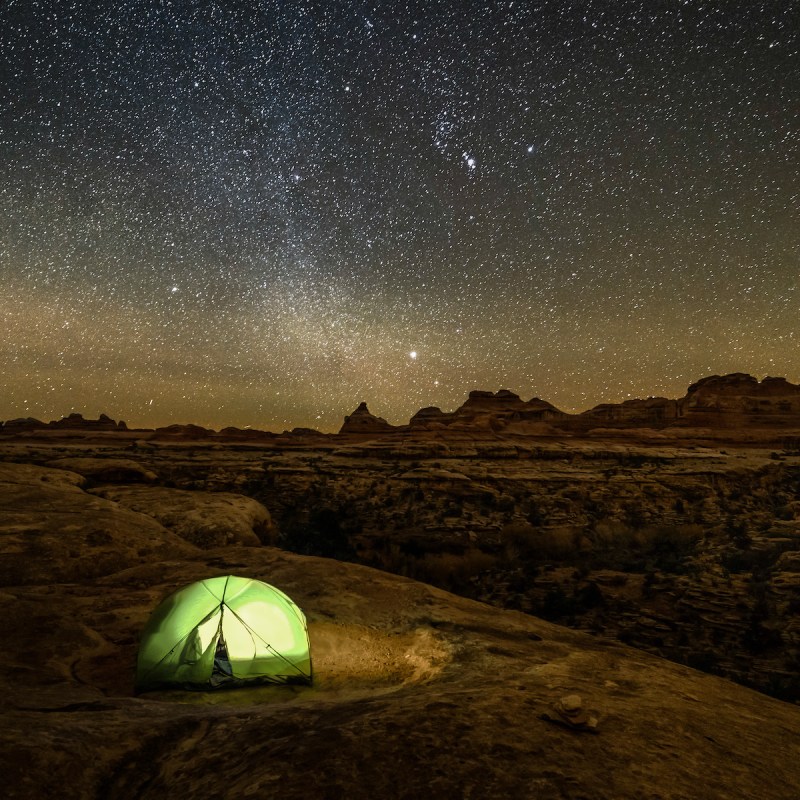
The mighty national parks and scenic byways of Utah have a claim to fame that goes beyond their famous soaring arches, winding rivers, and towering buttes. Thanks to a stellar combination of factors that include high elevation, remote locations, and an arid climate, the southwestern U.S. state also boasts some of the darkest skies and best stargazing around.
Videos by TravelAwaits
While the glittering skies are certainly the stars of the nighttime scene, they are just a part of the show. From the spectacular rock formations and river canyons of Arches National Park and Canyonlands National Park near Moab to the spires and hoodoos of Bryce Canyon National Park and Kodachrome Basin State Park near Kanab, the Utah landscapes provide spectacular backdrops for the nightly light show.
The presence of a big, bright full moon tends to wash out the Milky Way, so stargazing is at its best the two weeks surrounding a new moon (when the moon’s unilluminated side is facing Earth). On a recent trip to Moab in southeastern Utah during a thin crescent moon, I was amazed at the huge night sky and the glowing Milky Way.
Here are seven picturesque Utah locations that are perfect for stargazing.
I was hosted by the Red Cliffs Lodge on my trip to Moab, but all views are my own.

1. Arches National Park
Located in southeastern Utah, just north of the gateway town of Moab, Arches National Park is among the numerous Utah parks certified as International Dark-Sky parks. Known for its more-than 2,000 sandstone arches, the park also features a sky full of stars that appear as the sun sets.
“Arches’ relative isolation from the artificial light of urban areas makes it an ideal place for viewing the night sky,” says the park’s website, adding that the naked eye is sufficient to witness a wealth of stars.
For an iconic view of the night sky, adventurous stargazers and photographers head to Delicate Arch, the 46-foot-high, free-standing sandstone arch featured on everything from Utah license plates to “Welcome to Utah” signs at the state borders. A partial view of the arch is visible from the Lower Delicate Arch Viewpoint via a 100-yard walk. A slightly less-obstructed view is available on a half-mile walk to the Upper Viewpoint, while an up-close look will require a 3-mile round-trip hike.

2. Red Cliffs Lodge
Upper Colorado River Scenic Byway
Backing up to Arches National Park in the southeast is the Upper Colorado River Scenic Byway, a winding highway (Utah 128) that runs for nearly 45 miles, much of it along the banks of the picturesque Colorado River bracketed by massive red cliffs.
One of the gems along Highway 128 is the Red Cliffs Lodge, a historic resort that features a wonderful combination of relaxation, luxury, and adventure. Perched on the banks of the Colorado River and bordered by 2,000-foot-high cliffs, Red Cliffs Lodge offers gorgeous vistas in every direction. The dusk view of the river from the deck of Red Cliffs’ Cowboy Grill is particularly lovely.
Red Cliffs also serves as a base for an enormous array of outdoor activities, from rafting and hiking to horseback riding. The resort can arrange pickups for rafting trips on the Colorado River through the Moab Adventure Center or hiking trips through Desert Highlights.
The lodge follows the region’s Dark-Sky procedures, and on a clear night, the sky overhead becomes illuminated with a dazzling display of stars. To help guests get a closer look, the lodge’s deluxe cabins are equipped with telescopes.
Pro Tip: Moab Museum Of Film And Western Heritage
Red Cliffs is also known for its fascinating ranching history and the region’s rich movie-filming past, all of which is memorialized in the lodge’s excellent Moab Museum of Film and Western Heritage.

3. Canyonlands National Park
Moab and the Upper Colorado Scenic Byway are also convenient bases for exploration of Canyonlands National Park, a sprawling park located about 30 miles southwest of Moab.
Known for its countless canyons that were carved by the Colorado River and its tributaries, Canyonlands is split into four districts: Islands in the Sky, The Needles, The Maze, and the rivers themselves.
Owing to its remoteness, Canyonlands is said to have some of the darkest skies in the contiguous 48 states. Like at Arches, the naked eye is sufficient to witness many of the stars.
A popular spot to take in the night vistas is the Mesa Arch, which sits at the end of a 0.6-mile hike at the edge of a cliff. Along with its great nighttime skies, the arch is also a classic sunrise spot that is popular among photographers.

4. Capitol Reef National Park
Located in south-central Utah, about 2 hours southwest of Moab and about 3 hours northeast of Kanab, Capitol Reef National Park features cliffs, canyons, domes, and bridges. It is located in a geologic feature called the Waterpocket Fold.
The national park’s website notes that with 21 International Dark-Sky Parks and Places, “Utah has the highest concentration in the world.” It adds that Capitol Reef offers the best among the best when it comes to stargazing conditions.
The Capitol Reef website offers a number of suggestions for viewing the night skies from the park’s several districts.

5. Bryce Canyon National Park
With its sea of hoodoos lending a mysterious air, Bryce Canyon National Park is another magnificent spot for taking in Utah’s night skies. The park boasts the largest concentration of hoodoos on Earth and the distinctive rock columns stretch as far as the eye can see.
The national park’s website refers to Bryce as “the ultimate place to learn about and enjoy the splendor of the night sky.” The park is located far from the light pollution of civilization, about an hour and a half northwest of Kanab and 4 hours south of Salt Lake City. On a moonless night, visitors can expect to take in thousands of stars, with the Milky Way extending from horizon to horizon.
Pro Tip: Astronomy Ranger Programs
From a night-sky telescope program to a full-moon hike, Bryce Canyon offers plenty of opportunities for learning about the night skies. More information about ranger-led programs is available on Bryce Canyon’s website.

6. Dinosaur National Monument
With prehistoric dinosaur history all around and the huge skies of eastern Utah/western Colorado overhead, Dinosaur National Monument offers a truly epic stargazing experience.
Dinosaurs once roamed the mountains, deserts, and rivers of the area, and that history is at the heart of the national monument. But the remoteness of the area also makes it a natural for looking up at the sky.
While much of the monument — which straddles the Utah/Colorado border about 3 and a half hours southeast of Salt Lake City — is prime stargazing territory, the monument also has a designated spot for stargazing in the Split Mountain Campground. Stargazing programs take place there in the summer months.

7. Kodachrome Basin State Park
The national parks and monuments are not the only Utah spots known for their dark skies. Many of the state parks in Utah are also Dark-Sky-certified, including the spectacular Kodachrome Basin State Park.
Located about 2 hours northeast of Kanab and about 4 and a half hours south of Salt Lake City, Kodachrome Basin is named for its photogenic qualities. That extends to the nighttime hours as well as the gorgeously sunny days.
With its 67 monolithic stone spires and remote location, Kodachrome Basin offers the perfect setting to watch the stars appear overhead.
Other Utah State Parks that are Dark-Sky-certified include Antelope Island State Park, Dead Horse Point State Park, Goblin Valley State Park, Jordanelle State Park, and Steinaker State Park.
Pro Tip: Meteor Showers
Along with the nightly splendor of the Milky Way, Utah’s dark skies also offer great spots to take in occasional meteor showers, such as the Geminid meteor shower coming up in late 2023. Billed as one of the largest of the year, the meteor shower will peak in mid-December 2023.
